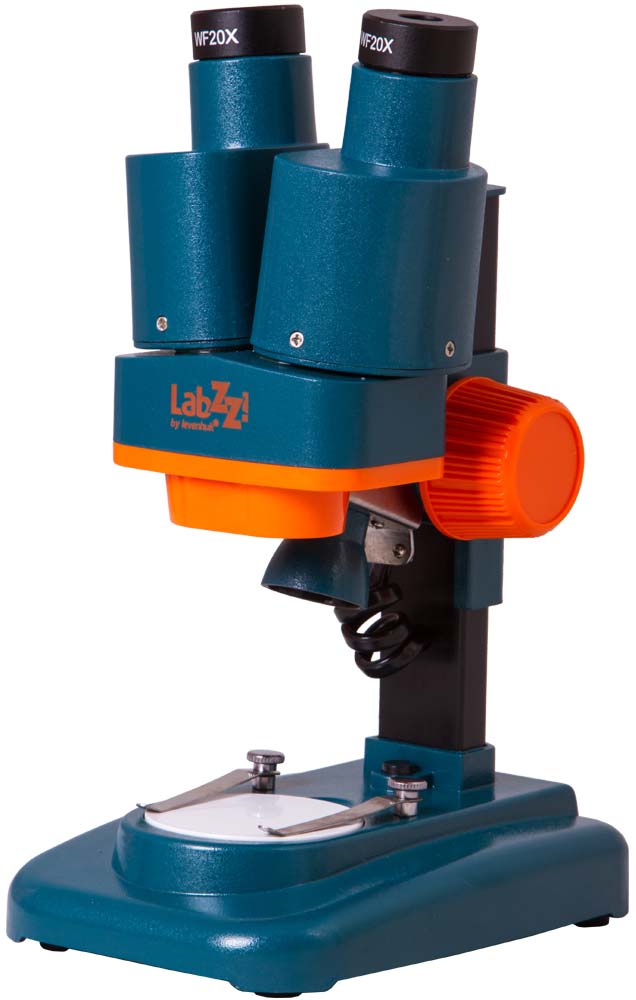Levenhuk LabZZ M4 Stereo Microscope
Magnification: 40x. Stereo Microscope. Working distance: 75mm
| Product ID | 70789 |
| Brand | Levenhuk, Inc., USA |
| Warranty | lifetime |
| EAN | 5905555011509 |
| Package size (LxWxH) | 6.7x5.1x9.8 in |
| Shipping Weight | 1.7 lb |
Levenhuk LabZZ M4 Stereo Microscope is perfect for studying large minerals, rocks, coins, soil samples, plants or insects. This model is designed specifically for kids. The microscope is relatively small, lightweight, and easy to handle – it will help a young biologist conduct real scientific experiments and learn more about the world around us.
The microscope has a convenient binocular head and objective lens of 2x magnification. You can use the two 20x wide field eyepieces included in the kit, and get total magnification of 40x. Stereo images render the tiniest details of an observed object. The large field of view allows studying extended objects, and 40x magnification helps to learn textures in detail.
The prepared slides are affixed to the round stage and are fixed with metal clips. Under insufficient light conditions, the upper LED illumination will be helpful. It is powered by 2 AA batteries (not included).
The kit includes:
- Levenhuk LabZZ M4 Stereo Microscope
- Two WF20x eyepieces
- Dust cover
- User manual and lifetime warranty
Levenhuk LabZZ M4 Stereo Microscope is compatible with Levenhuk digital cameras (purchased separately). Levenhuk digital cameras are installed in the eyepiece tube instead of the eyepiece.
| Product ID | 70789 |
| Brand | Levenhuk, Inc., USA |
| Warranty | lifetime |
| EAN | 5905555011509 |
| Package size (LxWxH) | 6.7x5.1x9.8 in |
| Shipping Weight | 1.7 lb |
| Type | stereo/instrumental |
| Microscope head type | binocular |
| Optics material | optical glass |
| Head | fixed (non-rotatable) |
| Head inclination angle | not angled |
| Magnification, x | 40 |
| Eyepiece tube diameter, in | 0.9 |
| Eyepieces | WF20x (2 pcs.) |
| Objectives | 2x |
| Working distance, in | 3 |
| Interpupillary distance, in | 2 — 3 |
| Stage, mm | Ø50 |
| Stage moving range, mm | fixed |
| Stage features | white plate, with clips |
| Focus | coarse: 35mm |
| Body | plastic |
| Illumination | LED |
| Power supply | 2 AA batteries (not included) |
| Power supply: batteries/built-in battery | yes |
| Operating temperature range, °F | 23...+104 |
| User level | for children |
| Assembly and installation difficulty level | extremely simple |
| Application | children (3-7 year old), for applied research |
| Illumination location | upper |
| Research method | bright field |
We have gathered answers to the most frequently asked questions to help you sort things out
Find out why studying eyes under a microscope is entertaining; how insects’ and arachnids’ eyes differ and what the best way is to observe such an interesting specimen
Read this review to learn how to observe human hair, what different hair looks like under a microscope and what magnification is required for observations
Learn what a numerical aperture is and how to choose a suitable objective lens for your microscope here
Learn what a spider looks like under microscope, when the best time is to take photos of it, how to study it properly at magnification and more interesting facts about observing insects and arachnids
This review for beginner explorers of the micro world introduces you to the optical, illuminating and mechanical parts of a microscope and their functions
Short article about Paramecium caudatum - a microorganism that is interesting to observe through any microscope
The Levenhuk LabZZ M101 is better suited for children than the Levenhuk LabZZ M4 for several reasons:
The M101 offers 6 magnification levels (up to 640x) via a sliding eyepiece (10x–16x) and three objectives (4x, 10x, 40x). This allows kids to explore transparent specimens like cells, microorganisms, or plant structures in detail, which is more aligned with classic "microscope experiments" they might encounter in school.
The M4, by contrast, is a stereo microscope with fixed 40x magnification (2x objective + 20x eyepieces), ideal for observing opaque 3D objects (e.g., rocks, coins, insects) but limited for studying cellular biology.
The M101 includes the Levenhuk K50 Experiment Kit, with prepared slides.This structured approach makes learning engaging and accessible.
The M4 lacks such a kit, requiring kids/parents to source their own specimens, which may be less intuitive but more fun.
The M101 mimics compound microscopes used in schools, preparing kids for classroom science. Its ability to study cells, bacteria, and pond water aligns with common STEM curricula.
The M4, while great for geology or entomology, doesn’t support the same depth of biological exploration.
Is there any additional information you might need?
















